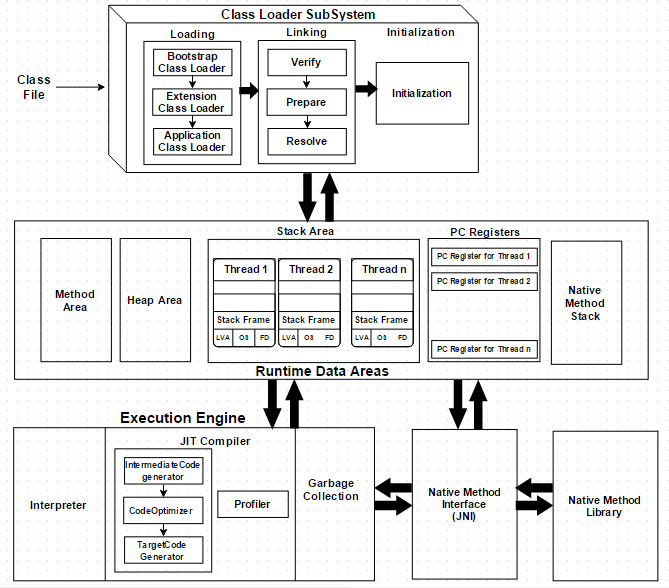The Java Virtual Machine (JVM) is the bedrock of a vast and dynamic ecosystem, powering everything from massive enterprise systems to innovative AI-driven applications. For developers, staying current isn’t just a matter of accessing new features; it’s a critical practice for ensuring security, performance, and stability. The regular release of JDK updates by providers like Adoptium, Oracle, Azul, and Amazon is the lifeblood of this ecosystem, delivering essential patches and subtle performance enhancements. While these updates might seem routine, they represent the ongoing commitment to Java’s robustness and its adaptation to modern computing challenges.
This article delves into the significance of these regular JVM updates, exploring what they contain and why they are non-negotiable for any serious Java application. We’ll then expand our view to the broader landscape, examining the revolutionary changes brought by projects like Loom and Panama, the exciting integration of AI through frameworks like Spring AI, and the best practices every developer should adopt to navigate this ever-evolving platform. From core Java SE news to the latest in the Spring and Jakarta EE worlds, we’ll cover the essential developments that define modern Java development.
The Anatomy of a JDK Update: Security, Stability, and Performance
At first glance, a version number increment like 17.0.15 to 17.0.16 might seem minor. However, these quarterly updates, often referred to as Critical Patch Updates (CPUs), are foundational to maintaining a healthy and secure application environment. They are a core part of the ongoing Java news cycle for Long-Term Support (LTS) versions, including the workhorses of the industry: Java 8, 11, 17, and the current LTS, Java 21.
What’s Inside a Maintenance Release?
These updates are a curated collection of fixes and improvements, primarily focused on three areas:
- Security Vulnerabilities: The most critical component. These patches address Common Vulnerabilities and Exposures (CVEs) discovered in the JVM and core libraries. Ignoring these can leave applications exposed to remote code execution, denial-of-service attacks, and other threats. This is a cornerstone of Java security news.
- Bug Fixes: These resolve functional issues, from obscure garbage collector bugs to incorrect API behavior. They enhance the overall stability and predictability of the platform.
- Minor Performance Tweaks: While major performance gains are reserved for feature releases, maintenance updates often include small optimizations in garbage collection, JIT compilation, or core library implementations, contributing to incremental Java performance news.
Managing your project’s Java version is straightforward with modern build tools. Both Maven and Gradle provide mechanisms to enforce a specific Java version, ensuring consistency across development and deployment environments. It’s a best practice to specify the latest patch release of your chosen LTS version.
Here’s how you can configure this in your Maven pom.xml, which is essential Maven news for any team:
<?xml version="1.0" encoding="UTF-8"?>
<project xmlns="http://maven.apache.org/POM/4.0.0"
xmlns:xsi="http://www.w3.org/2001/XMLSchema-instance"
xsi:schemaLocation="http://maven.apache.org/POM/4.0.0 http://maven.apache.org/xsd/maven-4.0.0.xsd">
<modelVersion>4.0.0</modelVersion>
<groupId>com.example</groupId>
<artifactId>jvm-news-app</artifactId>
<version>1.0-SNAPSHOT</version>
<properties>
<maven.compiler.source>21</maven.compiler.source>
<maven.compiler.target>21</maven.compiler.target>
<project.build.sourceEncoding>UTF-8</project.build.sourceEncoding>
</properties>
<build>
<plugins>
<plugin>
<groupId>org.apache.maven.plugins</groupId>
<artifactId>maven-enforcer-plugin</artifactId>
<version>3.4.1</version>
<executions>
<execution>
<id>enforce-java</id>
<goals>
<goal>enforce</goal>
</goals>
<configuration>
<rules>
<requireJavaVersion>
<!-- Use a version range to allow for security patches -->
<version>[21.0.8,)</version>
</requireJavaVersion>
</rules>
</configuration>
</execution>
</executions>
</plugin>
</plugins>
</build>
</project>This configuration not only sets the source and target to Java 21 but also uses the Maven Enforcer Plugin to mandate that the build environment uses at least version 21.0.8, preventing builds with older, potentially insecure JDKs.
The Concurrency Renaissance: Project Loom’s Virtual Threads in Practice
Beyond security patches, the Java ecosystem news has been dominated by major feature advancements. The most impactful of these is Project Loom, which delivered Virtual Threads, a feature that became production-ready in Java 21. This is a game-changer for building high-throughput, concurrent applications, particularly those with I/O-bound workloads like microservices and web applications.
From Platform Threads to Virtual Threads

Traditionally, Java threads were a thin wrapper over operating system (OS) threads. These “platform threads” are a scarce and heavy resource. Creating thousands of them can quickly exhaust system memory and lead to performance degradation from frequent context switching. This limitation has been a major driver behind the rise of complex, asynchronous programming models, which often lead to callback hell and harder-to-debug code. This is central to any discussion of Reactive Java news.
Virtual threads, part of the exciting Java virtual threads news, solve this problem. They are lightweight threads managed by the JVM, not the OS. Millions of virtual threads can be created, and they consume an OS thread only when performing CPU-bound work. When a virtual thread blocks on I/O, the JVM “unmounts” it from the OS thread, allowing that OS thread to run another virtual thread. This achieves massive scalability with a simple, synchronous, thread-per-request programming model.
Consider a simple web server task that makes a blocking call to another service:
import java.io.IOException;
import java.net.URI;
import java.net.http.HttpClient;
import java.net.http.HttpRequest;
import java.net.http.HttpResponse;
import java.util.concurrent.Executors;
public class TraditionalConcurrency {
public static void main(String[] args) {
// Using a cached thread pool of heavy OS threads
try (var executor = Executors.newCachedThreadPool()) {
for (int i = 0; i < 10_000; i++) {
int taskId = i;
executor.submit(() -> {
try {
// This blocking call ties up an OS thread
HttpResponse<String> response = HttpClient.newHttpClient().send(
HttpRequest.newBuilder().uri(URI.create("https://api.example.com/data")).build(),
HttpResponse.BodyHandlers.ofString()
);
System.out.println("Task " + taskId + " completed with status: " + response.statusCode());
} catch (IOException | InterruptedException e) {
Thread.currentThread().interrupt();
System.err.println("Task " + taskId + " failed: " + e.getMessage());
}
});
}
}
}
}Running the code above with 10,000 tasks would create a huge number of platform threads, likely crashing the application with an OutOfMemoryError. Now, let’s see the same logic with virtual threads, a key piece of Java 21 news:
import java.io.IOException;
import java.net.URI;
import java.net.http.HttpClient;
import java.net.http.HttpRequest;
import java.net.http.HttpResponse;
import java.util.concurrent.Executors;
public class VirtualThreadsConcurrency {
public static void main(String[] args) {
// The magic is here: a new executor for lightweight virtual threads
try (var executor = Executors.newVirtualThreadPerTaskExecutor()) {
for (int i = 0; i < 10_000; i++) {
int taskId = i;
executor.submit(() -> {
try {
// This blocking call now "unmounts" the virtual thread, freeing the OS thread
HttpResponse<String> response = HttpClient.newHttpClient().send(
HttpRequest.newBuilder().uri(URI.create("https://api.example.com/data")).build(),
HttpResponse.BodyHandlers.ofString()
);
System.out.println("Task " + taskId + " completed with status: " + response.statusCode());
} catch (IOException | InterruptedException e) {
Thread.currentThread().interrupt();
System.err.println("Task " + taskId + " failed: " + e.getMessage());
}
});
}
} // The executor automatically waits for all tasks to complete
}
}This version handles 10,000 concurrent tasks with ease, using only a small, fixed number of OS threads. The code remains simple, readable, and easy to debug. This paradigm shift is a huge piece of Java concurrency news and is already being integrated into major frameworks, as seen in recent Spring Boot news, where Tomcat can be configured to use virtual threads for handling incoming requests.
Bridging Worlds: Native Integration and the Rise of AI in Java
The Java platform continues to break down barriers, improving its interoperability with non-Java code and embracing the global trend of Artificial Intelligence. Two key areas of development are Project Panama and the burgeoning AI library ecosystem.
Project Panama: A Modern Successor to JNI
For decades, interacting with native C/C++ libraries from Java required the Java Native Interface (JNI). JNI is powerful but notoriously complex, error-prone, and unsafe. The latest Project Panama news is that its core component, the Foreign Function & Memory (FFM) API, is now a standard feature in Java 22 (and was in preview in Java 21). It provides a pure-Java, safe, and efficient way to call native functions and access native memory.
Imagine you need to call the standard C library function `strlen` to find the length of a null-terminated string. With the FFM API, the code is surprisingly clean:
import java.lang.foreign.*;
import java.lang.invoke.MethodHandle;
public class PanamaFFMExample {
public static void main(String[] args) throws Throwable {
// 1. Get a lookup object for symbols in the standard C library
SymbolLookup stdlib = Linker.nativeLinker().defaultLookup();
// 2. Get a handle to the 'strlen' function
MethodHandle strlen = Linker.nativeLinker().downcallHandle(
stdlib.find("strlen").orElseThrow(),
FunctionDescriptor.of(ValueLayout.JAVA_LONG, ValueLayout.ADDRESS)
);
// 3. Allocate some off-heap memory and copy a Java string into it
try (Arena arena = Arena.ofConfined()) {
MemorySegment cString = arena.allocateFrom("Hello, Panama!");
// 4. Invoke the native function
long length = (long) strlen.invokeExact(cString);
System.out.println("Length of the string is: " + length); // Outputs: 16
}
}
}This approach eliminates the need for C “glue code” and complex build steps, making it far easier to leverage high-performance native libraries for tasks like scientific computing, video processing, or interacting with OS-specific APIs.
Java and AI: A Powerful Combination
The AI revolution is here, and the Java community is rapidly building tools to participate. While Python has dominated the space, Java’s performance, stability, and vast enterprise footprint make it a compelling platform for deploying AI models. Recent Spring AI news and developments around libraries like LangChain4j are making it easier than ever.

These frameworks provide high-level abstractions for interacting with Large Language Models (LLMs) like OpenAI’s GPT or Google’s Gemini. They handle the complexities of API calls, prompt templating, response parsing, and chaining calls together to build sophisticated AI-powered features. This is a fast-moving area, with tools like JobRunr also exploring AI integrations for background job processing.
Best Practices and Future-Proofing Your Java Applications
Navigating the modern Java landscape requires a proactive mindset. Simply writing code is not enough; developers must be good stewards of their applications and the platform they run on.
Embrace Regular Updates
As discussed, staying on the latest patch release of your chosen LTS version (e.g., Java 17 news, Java 21 news) is paramount. Establish a process for quarterly testing and deployment of these updates. Use containerization and robust CI/CD pipelines to make this process repeatable and low-risk. The myth that Java is stagnant is a form of “Java psyop” that can be easily debunked by looking at the vibrant release cadence from various OpenJDK news sources like Adoptium news, Azul Zulu news, and Amazon Corretto news.
Master Your Tooling
Stay informed about the latest Gradle news and Maven news. Modern build tools are constantly improving dependency management, build performance, and integration with new Java features. Likewise, keep your testing frameworks up-to-date. The latest JUnit news and Mockito news often include better support for new language features and improved developer ergonomics.

Look to the Future: Project Valhalla
While Loom and Panama are here today, the next major evolution on the horizon is Project Valhalla news. Valhalla aims to introduce value objects and primitive classes, allowing developers to create flat, dense, cache-friendly data structures with the performance of primitives but the semantics of classes. This will have a profound impact on high-performance computing and data-intensive applications, further enhancing Java’s performance credentials.
Continuous Learning
The Java world is vast, encompassing everything from Java Card news for embedded devices to Jakarta EE news for large-scale enterprise systems. For those on a Java self-taught journey, focusing on core principles and then exploring these specialized areas is a great path. Following Java wisdom tips news from community leaders and regularly reading blogs and release notes is essential for professional growth.
Conclusion: A Platform Reimagined
The Java platform is more dynamic and powerful than ever. The steady stream of critical security and maintenance updates provides a stable foundation, while groundbreaking projects are fundamentally reshaping what’s possible. Virtual Threads have democratized high-concurrency programming, making it accessible to all developers without the complexity of reactive frameworks. The FFM API is opening new doors for native integration, and the burgeoning AI ecosystem is positioning Java as a key player in the next wave of software innovation.
For developers, the key takeaway is clear: stay engaged. Apply the security patches, experiment with the new features like virtual threads, and keep an eye on the future with projects like Valhalla. By embracing this continuous evolution, you can build applications that are not only secure and performant today but also ready for the challenges of tomorrow. The pulse of the JVM is strong, and it’s an exciting time to be a Java developer.

